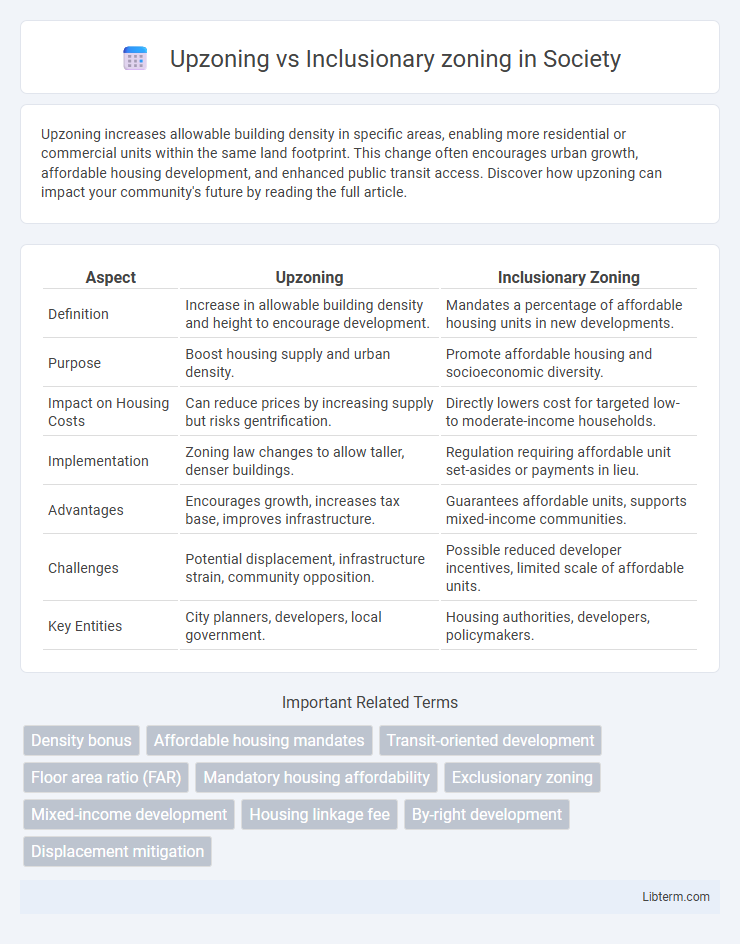Upzoning increases allowable building density in specific areas, enabling more residential or commercial units within the same land footprint. This change often encourages urban growth, affordable housing development, and enhanced public transit access. Discover how upzoning can impact your community's future by reading the full article.
Table of Comparison
| Aspect | Upzoning | Inclusionary Zoning |
|---|---|---|
| Definition | Increase in allowable building density and height to encourage development. | Mandates a percentage of affordable housing units in new developments. |
| Purpose | Boost housing supply and urban density. | Promote affordable housing and socioeconomic diversity. |
| Impact on Housing Costs | Can reduce prices by increasing supply but risks gentrification. | Directly lowers cost for targeted low- to moderate-income households. |
| Implementation | Zoning law changes to allow taller, denser buildings. | Regulation requiring affordable unit set-asides or payments in lieu. |
| Advantages | Encourages growth, increases tax base, improves infrastructure. | Guarantees affordable units, supports mixed-income communities. |
| Challenges | Potential displacement, infrastructure strain, community opposition. | Possible reduced developer incentives, limited scale of affordable units. |
| Key Entities | City planners, developers, local government. | Housing authorities, developers, policymakers. |
Introduction to Urban Zoning Policies
Urban zoning policies like upzoning and inclusionary zoning play crucial roles in shaping city development and housing affordability. Upzoning allows increased building density by changing land use regulations, enabling taller structures and more units within existing neighborhoods. Inclusionary zoning mandates that a percentage of new developments be allocated as affordable housing, promoting socioeconomic diversity within urban areas.
What is Upzoning?
Upzoning refers to the process of changing zoning laws to allow for higher density development, such as taller buildings or more units per lot, aimed at increasing housing supply. It often involves modifying zoning classifications to accommodate multifamily residences instead of single-family homes, thereby promoting urban growth. This strategy is used to address housing shortages and support sustainable city expansion by maximizing land use efficiency.
Defining Inclusionary Zoning
Inclusionary zoning mandates a specified portion of new housing developments be affordable to low- and moderate-income residents, promoting socioeconomic diversity within communities. This policy contrasts with upzoning, which primarily increases density and allows for taller or larger buildings without guaranteeing affordable units. By integrating affordable housing requirements directly into zoning laws, inclusionary zoning aims to address housing inequities and prevent displacement in high-demand areas.
Key Goals of Upzoning and Inclusionary Zoning
Upzoning primarily aims to increase residential density by allowing taller buildings or more units per acre, thereby addressing housing shortages and promoting urban growth. Inclusionary zoning focuses on integrating affordable housing within new developments to ensure economic diversity and combat displacement. Both strategies strive to improve housing availability but differ as upzoning emphasizes quantity and scale while inclusionary zoning mandates affordability and equitable access.
How Upzoning Impacts Housing Supply
Upzoning increases housing supply by allowing higher density developments in previously low-density zones, enabling more residential units per acre and accelerating the construction of apartments and multifamily buildings. This policy can reduce housing shortages by maximizing land use and promoting vertical growth, particularly in urban areas with limited space. However, the impact on affordability varies depending on local market conditions and complementary housing policies.
Inclusionary Zoning and Affordable Housing
Inclusionary zoning is a land-use policy requiring developers to allocate a percentage of new housing units as affordable housing, directly addressing housing affordability within urban areas. This strategy promotes mixed-income communities by integrating low- and moderate-income residences into market-rate developments, improving social equity and access. Inclusionary zoning contrasts with upzoning, which increases allowable density without explicit affordable housing mandates, making it a targeted approach to expanding affordable housing supply.
Comparing Economic Effects
Upzoning increases housing supply by allowing higher-density development, which often leads to lower housing prices and stimulates local economic growth through increased property values and construction activity. Inclusionary zoning mandates affordable housing units within new developments, potentially limiting market-rate supply and raising costs for developers, which can lead to higher overall housing prices or slowed construction. Economic studies show upzoning generally promotes broader market affordability and job creation, while inclusionary zoning primarily targets equity but may constrain supply and investment incentives.
Social Equity and Community Outcomes
Upzoning increases housing density by allowing taller buildings or more units per lot, potentially boosting affordable housing supply but often risking displacement without targeted protections. Inclusionary zoning mandates a portion of new developments be affordable, directly addressing social equity by integrating low-income units within market-rate projects. Both policies impact community outcomes differently; upzoning can stimulate growth and diversity if combined with equity measures, while inclusionary zoning ensures affordable housing access but may limit overall housing supply if not carefully balanced.
Implementation Challenges and Controversies
Upzoning often faces challenges related to community opposition and concerns over increased density impacting infrastructure, while inclusionary zoning encounters controversies regarding the financial feasibility for developers and potential reductions in overall housing supply. Implementation of upzoning requires navigating complex zoning laws and balancing growth with neighborhood character preservation. Inclusionary zoning policies can struggle with enforcement and ensuring affordability levels meet local needs without discouraging new construction.
The Future of Urban Zoning Strategies
Upzoning allows increased building density and height limits, encouraging affordable housing supply through market-driven development, while inclusionary zoning mandates a percentage of new units be affordable within private projects, directly addressing housing accessibility. Future urban zoning strategies will likely integrate data analytics and community input to balance growth with equitable housing outcomes. Emerging trends emphasize hybrid models combining upzoning flexibility with inclusionary mandates to promote sustainable, inclusive cityscapes.
Upzoning Infographic

 libterm.com
libterm.com